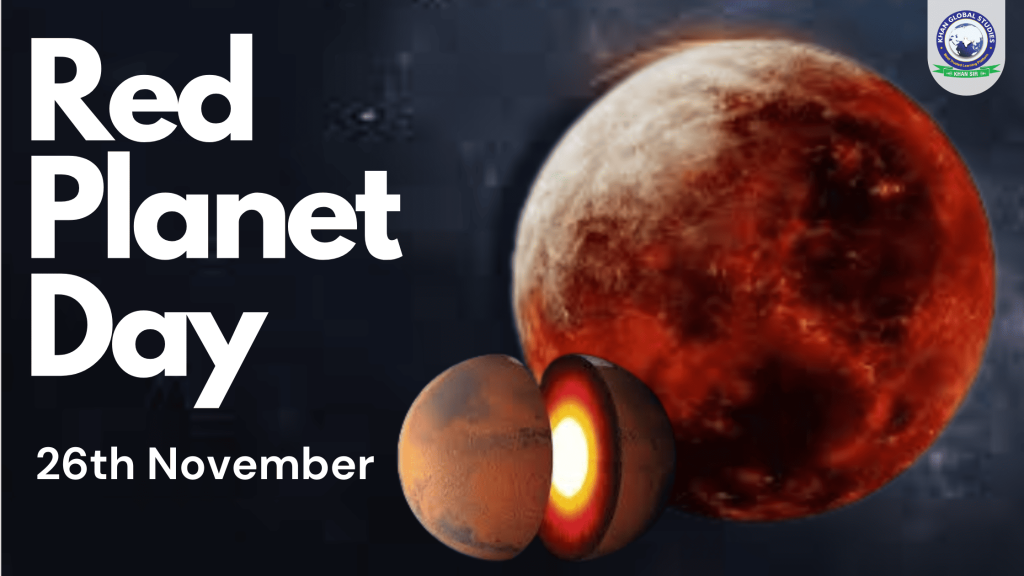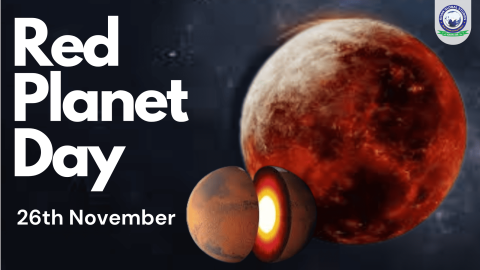November 28 is “Red Planet Day”, commemorating the beginning of one of the most important space missions to Mars. On November 28, 1964, the spacecraft Mariner 4 was launched, which is known as the first successful flyby mission to Mars. This spacecraft reached Mars on July 14, 1965 and sent 22 photographs of the surface of Mars. These photographs were the first close-up photographs obtained from deep space. This was the first time a spacecraft flew near Mars and took close-up photographs of another planet. After this, interest in Mars increased and many space missions were launched. Currently, the idea of establishing a human colony on Mars has also come up, which has been enthusiastically supported by billionaires like Elon Musk.
Information about planet Mars
- The fourth planet from the Sun, known as the Red Planet or Mars, is a dusty, cold desert planet with a thin atmosphere.
- It has seasons, polar ice caps, deep valleys, dormant volcanoes, and evidence that it was once an even more active planet.
Interest in Mars in the 19th century
In the late 19th century, Italian astronomer Giovanni Schiaparelli observed some line-like patterns on the surface of Mars, which he called Canali. This was mistranslated as “canals”, leading to the belief that the canals were built by intelligent beings on Mars. This was an early example of the possibility of life on Mars.
Although scientists debunked the notion in the early 20th century, it persisted in science fiction and popular culture. Mars’s similarities to Earth fueled the imagination of it being a life-friendly planet.
Some Facts about Mars
- The iron oxide on the surface of Mars gives it a red color.
- Mars is half the size of Earth, but it is still the fourth largest planet.
- Mars’ minimum distance from Earth is about 33.9 million miles.
- It is the fourth planet from the Sun.
- Mars has two moons – Deimos and Phobos.
- The temperature here ranges between -191°F to 81°F.
- Mars has a thin atmosphere and is mainly composed of carbon dioxide.
- Mars has the highest mountain in the solar system, which is three times higher than Mount Everest.
- A year on Mars is equal to 687 days on Earth.
- In 2018 scientists found evidence of a lake under Mars’ polar ice cap.
- Another interesting fact is that due to the difference in gravity, a 100-pound person on Mars would weigh only 38 pounds.
How Many Countries have sent missions to Mars?
- Following the space exploration race between the US and the Soviet Union during the Cold War, several other countries also sent their missions to Mars.
- NASA has one lander (Mars InSight), one rover (Curiosity) and three orbiters (Mars Reconnaissance Orbiter, Mars Odyssey and MAVEN).
- ISRO’s orbiter (Mangalyaan-1) was a technology demonstration mission that collected data on surface geology, morphology, atmospheric processes and surface temperature.
- The European Union has two orbiters – Mars Express and ExoMars Trace Gas Orbiter.
- China and the UAE have one orbiter each – Tianwen-1 and Hope. The UAE’s mission will study the Martian atmosphere and try to understand how and why Mars lost its atmosphere.
1964: Mariner 4 Mission
- Mariner 4 sent back images of the Martian surface after an eight-month journey that showed moon-like impact craters. The onboard camera took 22 images, covering about 1% of Mars. These images were sent to Earth over four days.
- The mission failed to satisfy scientists’ hopes of habitability on Mars. The images showed a cratered surface but failed to provide information about the planet’s geological diversity.
Viking missions (1970s and 1980s)
- The Viking missions of the 1970s conducted chemical analyses of Martian soil and performed four biology experiments. In the 1980s scientists speculated that Mars might be the source of some meteorites based on their mineral and rock composition.
- In 1984, a study showed that the isotopic ratios of gases in the Martian atmosphere matched the ratios measured by the Viking spacecraft. This finding gave geochemists a way to study Martian samples and helped to understand the geochemical evolution of Mars.
2001: Odyssey and the Search for Water
- In 2001, the gamma-ray spectrometer on Mars Odyssey detected signs of hydrogen, suggesting it might be water ice.
- In 2008, NASA’s Phoenix mission tested snow and soil at Mars’ north pole, confirming that the hydrogen discovered by Mars Odyssey in 2002 was indeed water ice.
Mars Missions of other Countries
- After the Cold War, when space exploration competition between the US and the Soviet Union was at its peak, other countries also sent their missions to Mars.
- NASA has one lander (Mars InSight), one rover (Curiosity) and three orbiters (Mars Reconnaissance Orbiter, Mars Odyssey, MAVEN).
- India’s Mangalyaan-1 was a technology demonstration mission that collected data on aspects such as surface geology, atmospheric processes and temperature.
- The European Union has two orbiters – Mars Express and ExoMars Trace Gas Orbiter.
- China and the UAE have one orbiter each – Tianwen-1 and Hope.
- The UAE mission will study the Martian atmosphere and try to understand how and why Mars lost its atmosphere.
Conclusion
Red Planet Day symbolizes human curiosity about Mars and scientific progress in its exploration. The Mariner 4 mission in 1964 provided the first close-up images of Mars, expanding our understanding of the planet. Various space missions that followed helped us better understand the composition, geography and possibility of potential life on Mars. The exploration of Mars has inspired not only the scientific community but also the general public. The idea of the possibility of life and human presence on Mars continues to inspire scientific research and imagination.
FAQs
Question 1: When and why is Red Planet Day celebrated?
Answer: Red Planet Day is celebrated every year on November 28. This day is celebrated to commemorate the launch of the Mariner 4 spacecraft in 1964, which sent the first close-up pictures of Mars.
Question 2: Why is Mars called the Red Planet?
Answer: The abundance of iron oxide on the surface of Mars gives it a red color, due to which it is called the “Red Planet”.
Question 3: What was the main achievement of the Mariner 4 mission?
Answer: Mariner 4 made the first flyby of Mars and sent 22 close-up pictures, giving scientists important information about Mars.
Question 4: Which space missions have been successful on Mars?
Answer: NASA’s InSight, Curiosity and three orbiters (Mars Reconnaissance Orbiter, Mars Odyssey, MAVEN) are active on Mars. Apart from this, India’s Mangalyaan-1 and the European Union’s Mars Express and ExoMars Trace Gas Orbiter have also been successful missions.
Question 5: Is there water on Mars?
Answer: Yes, in 2001, Mars Odyssey found traces of hydrogen on Mars, which indicated the presence of water ice. In 2008, the Phoenix mission proved that water ice exists on the surface of Mars.
Question 6: What is the plan to establish a human settlement on Mars?
Answer: Industrialists and scientists like Elon Musk have considered the possibility of establishing a human settlement on Mars. Research and technological development is ongoing in this direction.
Question 7: What is the possibility of life on Mars?
Answer: According to the evidence found so far, there could have been favorable conditions for life on Mars in the past. Current research is trying to understand whether suitable conditions for life still exist.




